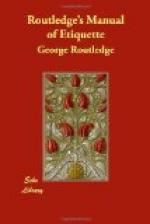It is never sufficiently considered that every one has her “points,” and that nothing so much offends as discrepancies. We remember a discussion upon female beauty, when instances were brought forward of persons who were conspicuous for their good looks, but who could not boast of one really perfect feature. The effect of the “tout ensemble” was good, and most attractive, but when the faces were pulled to pieces, it was impossible to say in what the beauty consisted. One of the critics wisely said, that it was to be found in the perfect harmony of feature and expression. All the features were on the same scale; no one feature overpowered the other, and the expression called into activity all features alike, so that there was perfect unity and harmony throughout. To compare small things with great, we should say that this supplies a good rule for dressing well. There should be no discrepancies. It should be harmonious, not only in itself, but harmonious with the person whom it is intended to adorn. It should be in keeping with face and figure. No two persons are exactly alike. Every one has her “points,” which constitute her beauty and her charm; and these “points” have to be attended to carefully. A woman who does this, with due regard to the rules of fashion, will always be well dressed. She will not buy or wear a thing simply because it has “just come from Paris,” nor be influenced by milliners and shopmen who assure her that the ugly article they exhibit is original in shape and style. Though fashion dictates, and she follows, yet she follows in a way of her own. She is never behind fashion, and never in advance of it. Perhaps her most admired “toilette” has been made at home, under her own eye, which has directed how far a compliance with the prevailing fashion suits her. She does not startle the world with a combination of strange colours, nor entertain her friends with a peculiarity of style and make. What she wears is prettily arranged, well made and well put on, and the effect is both pleasing and refreshing, and people inquire what house in Paris she patronizes. She is prudent; and, keeping her own secret, does not offend the fastidiousness of her fashionable friends by letting the truth eke out, that her much-admired Parisian “toilette” is, in every sense, of home-produce, but smiles at their approval, and follows her own plan, which is so successful in its results. Her costume is not expensive, and she contrives that, whatever she wears shall not offend against the laws of Fashion, while she declines to be its slave. She is not addicted to sham jewellery; she has no weakness for tinsel. What she wears is good of its kind, even when it is not costly. Wherever she goes, she impresses everyone with the fact that she is a true gentlewoman. She knows what is suited to her station and age, and, without conceit, understands what are her “points.” She is well aware that no woman can afford to be indifferent to her personal appearance, and that no law, human




